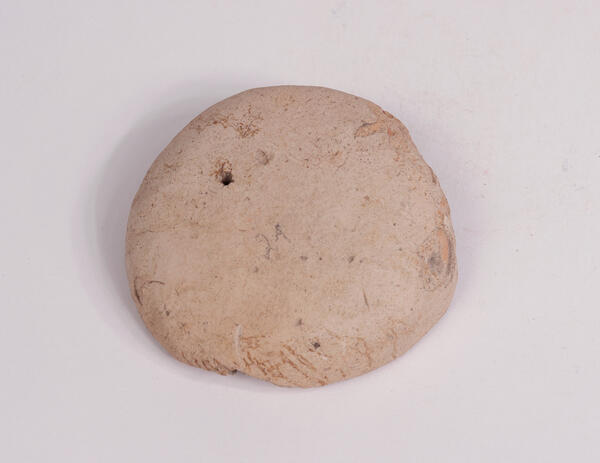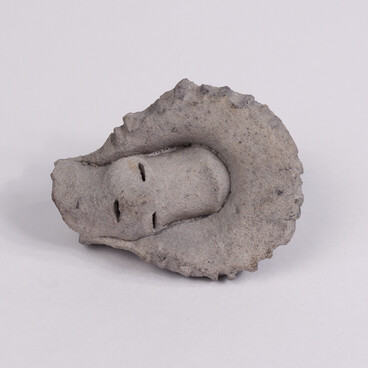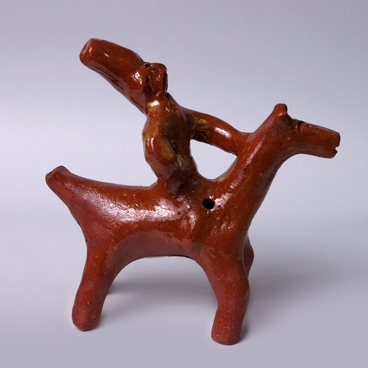This ancient rattle was presumably made in the 16th century in Stary Oskol by an unknown master. All Stary Oskol rattles could be classified into two types by their resemblance to either a cylinder or a sphere. At the same time, the craftsmen always left the toy base flat or slightly convex.
Judging by the found broken rattles and their fragments, the manufacturing technology was rather simple. The master modeled the two halves separately and connected both parts by placing either a clay ball or dry peas between them. The joint was coated with liquid clay, which was the most fragile part of a rattle. However, one old fragment among the others revealed that there had also been another technology: sometimes the halves were fixed together in an overlapping manner. After the clay dried out a little, holes were pierced in it before it was fired. All Stary Oskol rattles have one incision on the base and three incisions on their cylindrical part.
Rattles also varied in size — large, medium and small. The walls of large and medium-sized rattles were not as thick as those of the small ones, but at the same time, the volume of their internal cavity is greater. Therefore, they created a more resonant and louder sound. One of the researchers of the Stary Oskol clay toy Boris Shevchenko wrote that smaller rattles began to be made because of the peculiarities of the local clay. Stary Oskol raw materials contain bigger amounts of sand than others, which means that the firing process makes the items more fragile. Therefore, the craftsmen preferred to create more stocky and compact toys.
Rattles have been around for a very long time: some of them found in Eastern Europe date back as far as the second millennium BC. In Russia, rattles were made of clay, wood, birch bark, vine, bark, and leather. In the south, small dried special pumpkins were also used sometimes. The shape of rattles varied as well. Circular, spherical, cylindrical, cross-shaped toys were more common. Sometimes the craftsmen created the simplified stylized figures of birds, animals or women.
In some areas of Russia, rattles, apart from the usual ‘pogremushka’, also had other names: sharkunok, grematushka, pobryakushka. It was believed that the entertainment of the baby was not this toy’s only purpose: people believed that noise drives away evil spirits from the cradle and calls on good ones. The same properties were later attributed to whistle toys.
Judging by the found broken rattles and their fragments, the manufacturing technology was rather simple. The master modeled the two halves separately and connected both parts by placing either a clay ball or dry peas between them. The joint was coated with liquid clay, which was the most fragile part of a rattle. However, one old fragment among the others revealed that there had also been another technology: sometimes the halves were fixed together in an overlapping manner. After the clay dried out a little, holes were pierced in it before it was fired. All Stary Oskol rattles have one incision on the base and three incisions on their cylindrical part.
Rattles also varied in size — large, medium and small. The walls of large and medium-sized rattles were not as thick as those of the small ones, but at the same time, the volume of their internal cavity is greater. Therefore, they created a more resonant and louder sound. One of the researchers of the Stary Oskol clay toy Boris Shevchenko wrote that smaller rattles began to be made because of the peculiarities of the local clay. Stary Oskol raw materials contain bigger amounts of sand than others, which means that the firing process makes the items more fragile. Therefore, the craftsmen preferred to create more stocky and compact toys.
Rattles have been around for a very long time: some of them found in Eastern Europe date back as far as the second millennium BC. In Russia, rattles were made of clay, wood, birch bark, vine, bark, and leather. In the south, small dried special pumpkins were also used sometimes. The shape of rattles varied as well. Circular, spherical, cylindrical, cross-shaped toys were more common. Sometimes the craftsmen created the simplified stylized figures of birds, animals or women.
In some areas of Russia, rattles, apart from the usual ‘pogremushka’, also had other names: sharkunok, grematushka, pobryakushka. It was believed that the entertainment of the baby was not this toy’s only purpose: people believed that noise drives away evil spirits from the cradle and calls on good ones. The same properties were later attributed to whistle toys.



